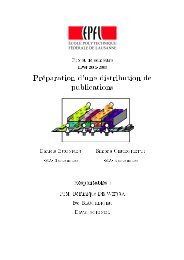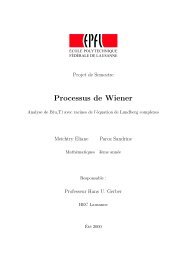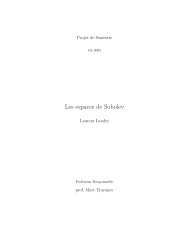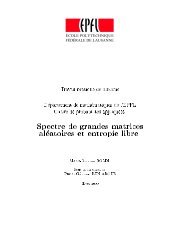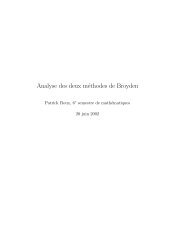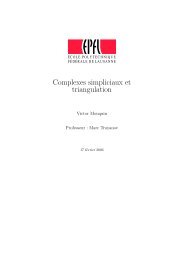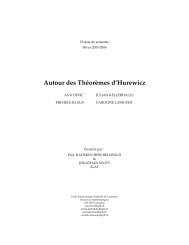Identification du dual topologique de C[a, b] Louis ... - CQFD - EPFL
Identification du dual topologique de C[a, b] Louis ... - CQFD - EPFL
Identification du dual topologique de C[a, b] Louis ... - CQFD - EPFL
You also want an ePaper? Increase the reach of your titles
YUMPU automatically turns print PDFs into web optimized ePapers that Google loves.
<strong>I<strong>de</strong>ntification</strong> <strong>du</strong><br />
<strong>du</strong>al <strong>topologique</strong> <strong>de</strong> C[a, b]<br />
<strong>Louis</strong> Fauchier-Magnan, SMA - <strong>EPFL</strong><br />
Prof. Antoine Derighetti - IACS<br />
juin 2005
Table <strong>de</strong>s matières<br />
Le <strong>du</strong>al <strong>topologique</strong> <strong>de</strong>s fonctions continues 5<br />
1. Notions preliminaires 5<br />
2. L’integrale <strong>de</strong> Stieltjes 8<br />
3. Le Théorème <strong>de</strong> Riesz 12<br />
4. <strong>I<strong>de</strong>ntification</strong> <strong>de</strong> C[a, b] ′ 14<br />
5. Conclusion 24<br />
Bibliographie 25<br />
3
Le <strong>du</strong>al <strong>topologique</strong> <strong>de</strong>s fonctions continues<br />
1. Notions preliminaires<br />
Définition 1.1. Soient a, b ∈ R, a < b. On pose<br />
C[a, b] := {f : [a, b] → R : f est continue sur [a, b]}.<br />
Remarque 1.2. On munit C[a, b] d’une structure <strong>de</strong> R-espace vectoriel<br />
en définissant : ∀f, g ∈ C[a, b], ∀λ ∈ R<br />
– (f + g)(x) := f(x) + g(x)<br />
– (λf)(x) := λf(x), ∀x ∈ R<br />
On munit C[a, b] d’une structure d’espace vectoriel normé grâce à l’application<br />
:<br />
‖ · ‖ : C[a, b] −→ [0, ∞)<br />
{ }<br />
‖f‖ := max |f(x)|<br />
x∈[a,b]<br />
Définition 1.3. On définit :<br />
– le <strong>du</strong>al algébrique <strong>de</strong> C[a, b] comme l’ensemble <strong>de</strong>s formes linéaires sur<br />
C[a, b], noté C[a, b] ∗ .<br />
– le <strong>du</strong>al <strong>topologique</strong> <strong>de</strong> C[a, b] comme l’ensemble <strong>de</strong>s formes linéaires<br />
continues sur C[a, b], noté C[a, b] ′ .<br />
Remarque 1.4. C[a, b] ′ ⊂ C[a, b] ∗<br />
Remarque 1.5. L’analyse fonctionnelle nous assure que la propriété <strong>de</strong><br />
continuité peut-être remplacée par le fait d’être borné, mais nous reprendrons<br />
ce point plus en détail.<br />
Définition 1.6. Soit f ∈ R [a,b] .<br />
f est dite monotone croissante si : ∀x, y ∈ [a, b], x < y ⇒ f(x) ≤ f(y)<br />
f est dite monotone décroissante si : ∀x, y ∈ [a, b], x < y ⇒ f(x) ≥ f(y)<br />
Définition 1.7. Soit un intervalle compact [a, b] ⊂ R et n ∈ N. Un<br />
ensemble <strong>de</strong> points {x 0 , . . . , x n } ⊂ [a, b] vérifiant :<br />
x 0 = a, x n = b, x i < x i+1 ∀ 0 ≤ i ≤ n − 1<br />
est appelé une subdivision (d’ordre n) <strong>de</strong> [a, b]<br />
Définition 1.8. Soient a, b ∈ R, avec a < b et f ∈ R [a,b] .<br />
On dit que f est à variation bornée sur [a, b] si ∃K > 0 tel que pour toute<br />
5
6 LE DUAL TOPOLOGIQUE DES FONCTIONS CONTINUES<br />
subdivision {x 0 , . . . , x n } d’ordre n <strong>de</strong> [a, b]<br />
n∑<br />
|f(x j ) − f(x j−1 )| ≤ K<br />
j=1<br />
Définition 1.9. L’ensemble <strong>de</strong>s fonctions à variation bornée sur [a, b]<br />
est noté BV [a, b]<br />
Proposition 1.1. BV [a, b] est un R-sous espace vectoriel <strong>de</strong> R [a,b]<br />
Preuve :<br />
Soient f, g ∈ BV [a, b] et λ, µ ∈ R.<br />
Soit n ∈ N et {x 0 , . . . , x n } une subdivision d’ordre n <strong>de</strong> [a, b].<br />
Alors<br />
n∑<br />
|(λf + µg)(x i ) − (λf + µg)(x i−1 )| ≤<br />
|λ| ·<br />
j=1<br />
n∑<br />
|f(x i ) − f(x i−1 )| + |µ| ·<br />
i=1<br />
car f, g ∈ BV [a, b].<br />
n∑<br />
|g(x i ) − g(x i−1 )| < ∞<br />
Proposition 1.2. Toute fonction f ∈ R [a,b] monotone croissante ou<br />
décroissante est à variation bornée.<br />
Preuve : Soit n ∈ N et {x 0 , . . . , x n } une subdivision d’ordre n <strong>de</strong> [a, b].<br />
Supposons f croissante. Alors :<br />
n∑<br />
|f(x j ) − f(x j−1 )| =<br />
j=1<br />
i=1<br />
n∑<br />
f(x j ) − f(x j−1 ) = f(x n ) − f(x 0 ) = f(b) − f(a)<br />
j=1<br />
Supposons f décroissante. Alors :<br />
n∑<br />
|f(x j ) − f(x j−1 )| =<br />
j=1<br />
n∑<br />
f(x j−1 ) − f(x j ) = f(x 0 ) − f(x n ) = f(a) − f(b)<br />
j=1<br />
Définition 1.10. Soit f ∈ BV [a, b].<br />
On appelle variation totale <strong>de</strong> f sur [a, b] le nombre :<br />
{ n∑<br />
}<br />
Va b (f) := sup |f(x j ) − f(x j−1 )| : n ∈ N, {x 0 , . . . , x n } subdivision <strong>de</strong> [a, b]<br />
j=1<br />
Proposition 1.3. Soit f ∈ BV [a, b] et a ≤ c < d ≤ b.<br />
Alors f |[c,d] ∈ BV [c, d].<br />
Preuve :<br />
Soit K > 0 tel que f ∈ BV [a, b].<br />
Soit {x 0 , . . . , x n } une subdivision <strong>de</strong> [c, d].<br />
Ainsi {a, x 0 , . . . , x n , b} est une subdivision <strong>de</strong> [a, b] et donc :<br />
n∑<br />
|f(c) − f(a)| + |f(x j ) − f(x j−1 )| + |f(b) − f(d)| ≤ K<br />
j=1
et donc<br />
1. NOTIONS PRELIMINAIRES 7<br />
n∑<br />
|f(x j ) − f(x j−1 )| ≤ K<br />
j=1<br />
Remarque 1.11. Nous énonçons ci-<strong>de</strong>ssous quelques résultats utilisés<br />
dans certaines démonstrations au chapitre suivant :<br />
Proposition 1.4. Soit f ∈ R [a,c]<br />
– Si f ∈ BV [a, c] et a < b < c, alors : V c<br />
a (f) = V b<br />
a (f) + V c<br />
b (f)<br />
– Si f |[a,b] ∈ BV [a, b] et f |[b,c] ∈ BV [b, c], alors f ∈ BV [a, c]<br />
Alors :<br />
Proposition 1.5. Soit f ∈ BV [a, b]. On définit :<br />
π(a) = 0 et π(x) := V x<br />
a (f), ∀x ∈ (a.b]<br />
– π ≥ 0 sur [a, b]<br />
– π est croissante sur [a, b]<br />
– Soit c ∈ [a, b], alors f est continue en c ⇔ π est continue en c<br />
Théorème 1.12. Jordan<br />
Toute fonction continue à variation bornée peut s’écrire comme différence<br />
<strong>de</strong> <strong>de</strong>ux fonctions continues monotones croissantes.<br />
Théorème 1.13. Premier Théorème d’Helly<br />
Soit une collection quelconque <strong>de</strong> fonctions F ⊂ R [a,b] .<br />
Si ∃K > 0 tel que<br />
|f| ≤ K et V b<br />
a (f) ≤ K , ∀f ∈ F<br />
alors il existe une suite {f n } n∈N ⊂ F qui converge en chaque point <strong>de</strong> [a, b]<br />
vers une fonction ϕ ∈ BV [a, b].<br />
Définition 1.14. Soit f ∈ R [0,1] . On appelle polynome <strong>de</strong> Bernstein <strong>de</strong><br />
<strong>de</strong>gré n <strong>de</strong> la fonction f la fonction :<br />
n∑ ( i<br />
B n (x) := f C<br />
n)<br />
nx i i (1 − x) n−i , ∀x ∈ [0, 1]<br />
où<br />
i=0<br />
C i n :=<br />
n!<br />
(n − i)! i! , i = 0, . . . , n<br />
Théorème 1.15. Bernstein<br />
Si f ∈ C[0, 1], alors ‖B n − f‖ −→ 0 quand n → ∞
8 LE DUAL TOPOLOGIQUE DES FONCTIONS CONTINUES<br />
2. L’integrale <strong>de</strong> Stieltjes<br />
Définition 2.1. Soient f, g ∈ R [a,b] Soit {x 0 , . . . , x n } une subdivision<br />
d’ordre n ∈ N <strong>de</strong> [a, b]. On choisit un point ξ k ∈ [x k , x k+1 ], ∀ 0 ≤ k ≤ n − 1.<br />
On forme ensuite la somme<br />
n−1<br />
∑<br />
ω := f(ξ k ) ( g(x k+1 ) − g(x k ) )<br />
k=0<br />
et on définit le pas λ := max{x k+1 − x k : 0 ≤ k ≤ n − 1}.<br />
Si la somme ω tend vers une limite finie Ω lorsque λ → 0 indépendamment<br />
<strong>du</strong> choix <strong>de</strong> la subdivision et <strong>de</strong>s ξ k , on appelle Ω l’intégrale <strong>de</strong> Stieltjes <strong>de</strong><br />
f par rapport à g<br />
Plus techniquement, Ω est l’intégrale <strong>de</strong> Stieltjes <strong>de</strong> f par rapport à g si :<br />
∀ɛ > 0, ∃δ > 0 tel que pour toute subdivision vérifiant λ < δ, | ω − Ω |< ɛ<br />
pour tout choix <strong>de</strong>s points ξ k . On la note ∫ b<br />
a f(x)dg(x)<br />
Proposition 2.1. Quelques propriétés fondamentales :<br />
– ∫ b<br />
a (f + g)(x)dh(x) = ∫ b<br />
a f(x)dh(x) + ∫ b<br />
a g(x)dh(x)<br />
– ∫ b<br />
a f(x)d(g + h)(x) = ∫ b<br />
a f(x)dg(x) + ∫ b<br />
a f(x)dh(x)<br />
– ∫ b<br />
a αf(x)d(βg)(x) = αβ ∫ b<br />
a f(x)dg(x)<br />
– ∫ b<br />
a f(x)d(g + C)(x) = ∫ b<br />
a<br />
f(x)dg(x) ∀α, β, C ∈ R<br />
– ∫ b<br />
a f(x)dg(x) = ∫ c<br />
a f(x)dg(x) + ∫ b<br />
c f(x)dg(x),<br />
∀a < c < b, ∀f, g, h ∈ R [a,b]<br />
(On suppose ici que toutes ces intégrales existent.)<br />
De plus, l’existence d’une <strong>de</strong>s <strong>de</strong>ux intégrales ∫ b<br />
a f(x)dg(x) et ∫ b<br />
a g(x)df(x)<br />
implique celle <strong>de</strong> l’autre et dans ce cas, on a la formule d’intégration par<br />
parties :<br />
∫ b<br />
a<br />
f(x)dg(x) +<br />
∫ b<br />
a<br />
g(x)df(x) = f(b)g(b) − f(a)g(a)<br />
Théorème 2.2. L’intégrale <strong>de</strong> Stieltjes ∫ b<br />
a<br />
f(x)dg(x) existe si f ∈ C[a, b]<br />
et g ∈ BV [a, b].<br />
Preuve :<br />
Supposons tout d’abord que g est monotone croissante sur [a, b]. Soit {x 0 , . . . , x n }<br />
une subdivision d’ordre n <strong>de</strong> [a, b].<br />
∀ 0 ≤ k ≤ n − 1, on définit<br />
m k := min { f(x) : x ∈ [x k , x k+1 ] }<br />
et<br />
M k := max { f(x) : x ∈ [x k , x k+1 ] }
2. L’INTEGRALE DE STIELTJES 9<br />
Ces nombres existent, car f ∈ C[a, b]. on forme les sommes inférieures <strong>de</strong> f<br />
et (respectivement) supérieures <strong>de</strong> f associées à cette subdivision :<br />
n−1<br />
∑ (<br />
s = m k g(xk+1 ) − g(x k ) ) n−1<br />
∑ (<br />
et S = M k g(xk+1 ) − g(x k ) )<br />
k=0<br />
Il est clair que s ≤ ω ≤ S pour tout choix <strong>de</strong>s points ξ k ∈ [x k , x k+1 ].<br />
De plus, on constate que si on rajoute <strong>de</strong>s points à la subdivision, s ne<br />
décroît pas et S ne croît pas. Par conséquent, si on choisit <strong>de</strong>ux subdivisions<br />
<strong>de</strong> [a, b], et on note s 1 , s 2 les sommes inférieures et respectivement S 1 , S 2<br />
les sommes supérieures associées à ces subdivisions, on peut obtenir une<br />
troisième subdivision <strong>de</strong> [a, b] en combinant les <strong>de</strong>ux premières. On note<br />
comme précé<strong>de</strong>mment s 3 et S 3 les sommes obtenues. Ainsi, par la remarque<br />
ci-<strong>de</strong>ssus, on observe que s 1 ≤ s 3 ≤ S 3 ≤ S 2 , et donc que s 1 ≤ S 2 . On<br />
observe que l’ensemble <strong>de</strong>s sommes inférieures <strong>de</strong> f est borné, car S 2 < ∞.<br />
On peut alors considérer I := sup{s}. Ainsi, pour toute subdivision <strong>de</strong> [a, b],<br />
on aura s ≤ I ≤ S et que |ω − I| ≤ S − s.<br />
f est continue sur [a, b] qui est compact, elle est donc uniformément continue,<br />
ie ∀ɛ > 0, ∃δ > 0 tel que ∀x, x ′ ∈ [a, b], |x − x ′ | < δ ⇒ |f(x) − f(x ′ )|.<br />
Ainsi, on constate que M k − m k < ɛ, 0 ≤ k ≤ n − 1 pour λ < δ (rappel : λ<br />
est le pas <strong>de</strong> la subdivision).<br />
Ainsi, S −s < ɛ·(g(b)−g(a)). On arrive par conséquent au résultat suivant :<br />
ce qui signifie<br />
On voit donc que<br />
k=0<br />
λ < δ ⇒| ω − I |< ɛ (g(b) − g(a))<br />
I =<br />
lim ω = I<br />
λ→0<br />
∫ b<br />
a<br />
f(x)dg(x)<br />
En ce qui concerne le cas plus général où g est à variation bornée, selon le<br />
théorème 1.1.1, on peut écrire g = g 1 − g 2 où g 1 , g 2 ∈ R [a,b] sont monotones<br />
croissantes sur [a, b]. On aura alors<br />
∫ b<br />
a<br />
f(x)dg(x) =<br />
∫ b<br />
a<br />
f(x)dg 1 (x) −<br />
∫ b<br />
a<br />
f(x)dg 2 (x)<br />
Théorème 2.3. Si f ∈ C[a, b] et g est dérivable sur [a, b] avec une<br />
dérivée Riemann-intégrable sur [a, b], alors :<br />
∫ b<br />
a<br />
f(x)dg(x) =<br />
∫ b<br />
a<br />
f(x)g ′ (x)dx<br />
où le membre <strong>de</strong> droite est l’intégrale classique <strong>de</strong> Riemann.<br />
Preuve :<br />
Il découle <strong>de</strong>s hypothèses que g ′ est bornée sur [a, b] et donc, selon le<br />
théorème <strong>de</strong>s accroissements finis, g ∈ BV [a, b]. Ainsi on sait que l’intégrale<br />
<strong>de</strong> gauche existe. De plus, on admet un résultat <strong>de</strong> théorie <strong>de</strong> l’intégration qui<br />
nous dit que, sous les hypothèses ci-<strong>de</strong>ssus, la fonction f(x)g’(x) est continue
10 LE DUAL TOPOLOGIQUE DES FONCTIONS CONTINUES<br />
presque partout, et donc qu’elle est intégrable. Les <strong>de</strong>ux membres <strong>de</strong> l’égalité<br />
existent donc, il reste à voir qu’ils sont égaux. On suppose, comme dans le<br />
théorème précé<strong>de</strong>nt, que g est monotone croissante sur [a, b]. Considérons<br />
une subdivision d’ordre n {x 0 , . . . , x n } <strong>de</strong> [a, b]. On applique à chaque sousintervalle<br />
[x k , x k+1 ] le théorème <strong>de</strong>s accroissements finis qui nous dit que<br />
∀ 0 ≤ k ≤ n−1, ∃ν k ∈ (x k , x k+1 ) tel que g(x k+1 )−g(x k ) = g ′ (ν k ) ( x k+1 −x k<br />
)<br />
En formant la somme ω donnée par la construction <strong>de</strong> l’intégrale <strong>de</strong> Stieltjes,<br />
on peut choisir ξ k = ν k , ∀ 0 ≤ k ≤ n − 1, car la convergence <strong>de</strong> l’intégrale,<br />
par définition, ne dépend pas <strong>du</strong> choix <strong>de</strong>s ξ k . On arrive donc au résultat :<br />
n−1<br />
∑<br />
ω = f(ν k )g ′ (ν k ) ( )<br />
x k+1 − x k<br />
i=0<br />
C’est une somme <strong>de</strong> Riemman pour la fonction f(x)g’(x). En redéfinissant<br />
la subdivision et en prenant la limite, on obtient que<br />
∫ b<br />
a<br />
f(x)dg(x) = lim<br />
λ→0<br />
ω =<br />
∫ b<br />
a<br />
f(x)g ′ (x)dx<br />
Le résultat pour g ∈ BV [a, b] se dé<strong>du</strong>it comme dans la fin <strong>de</strong> la preuve <strong>du</strong><br />
théorème précé<strong>de</strong>nt.<br />
Théorème 2.4. Second Théorème d’Helly (sans preuve)<br />
Soient f ∈ C[a, b] et {g n } n∈N ⊂ R [a,b] convergent point par point vers une<br />
fonction g ∈ R [a,b] . Si ∃K > 0 tel que<br />
alors<br />
∫ b<br />
lim<br />
n→∞<br />
a<br />
V b<br />
a (g n ) < K, ∀n ∈ N<br />
f(x)dg n (x) =<br />
∫ b<br />
a<br />
f(x)dg(x)<br />
Théorème 2.5. Soient f, g ∈ R [a,b] .<br />
Soient a < c 1 < c 2 < · · · < c m < b, alors si g est constante sur tous les<br />
sous-intervalles (a, c 1 ), (c 1 , c 2 ), . . . , (c m , b), on a :<br />
où<br />
Preuve :<br />
∫ b<br />
a<br />
f(x)dg(x) = f(a)(g(a + 0) − g(a)) +<br />
m∑<br />
f(c i )(g(c i + 0) − g(c i − 0)) + f(b)(g(b) − g(b − 0))<br />
i=1<br />
Il est facile <strong>de</strong> voir que<br />
V b<br />
a (g) = |g(a + 0) − g(a)| +<br />
g(x + 0) := lim g(x + µ), µ > 0<br />
µ→0<br />
g(x − 0) := lim g(x + µ), µ < 0<br />
µ→0<br />
n∑ {<br />
|g(ci ) − g(c i − 0)| + |g(c i + 0) − g(c i )| } + |g(b) − g(b − 0)|<br />
i=1
2. L’INTEGRALE DE STIELTJES 11<br />
On constate donc que g ∈ BV [a, b], et par conséquent que g est à variation<br />
bornée sur tout sous-intervalle <strong>de</strong> [a, b]. Ainsi :<br />
∫ b<br />
m∑<br />
∫ ci+1<br />
(1)<br />
f(x)dg(x) = f(x)dg(x)<br />
a<br />
i=0<br />
où nous avons posé c 0 := a et c m+1 = b. Etudions à présent ∫ c i+1<br />
c i<br />
f(x)dg(x).<br />
En subdivisant l’intervalle [c i , c i+1 ], et en formant la somme ω pour cet<br />
intervalle, on obtient :<br />
ω = f(ξ 0 )(g(c i + 0) − g(c i )) + f(ξ n−1 )(g(c i+1 ) − g(c i+1 − 0))<br />
car les autres termes se compensent. Par conséquent, en passant à la limite,<br />
on obtient<br />
∫ ci+1<br />
c i<br />
f(x)dg(x) = f(c i )(g(c i + 0) − g(c i )) + f(c i+1 )(g(c i+1 ) − g(c i+1 − 0))<br />
Le résultat suit immédiatement en remplaçant terme à terme dans l’équation<br />
(1.1)<br />
Théorème 2.6. Si f ∈ C[a, b] et g ∈ BV [a, b], alors<br />
∫ b<br />
∣ f(x)dg(x)<br />
∣ ≤ ‖f‖ · V a b (g)<br />
a<br />
Preuve :<br />
Soit un n ∈ N et une subdivision quelconque {x 0 , . . . , x n } <strong>de</strong> [a, b] d’ordre n.<br />
On choisit les ξ k ∈ [x k , x k+1 ] <strong>de</strong> manière arbitraire. Soit ω la somme dans la<br />
construction <strong>de</strong> l’intégrale <strong>de</strong> Stieltjes associée à cette subdivision et à ces<br />
ξ k . On a alors<br />
∣<br />
∣<br />
n−1<br />
∑<br />
‖f‖·n−1<br />
|ω| =<br />
f(ξ<br />
∣ k )(g(x k+1 ) − g(x k ))<br />
∣ ≤ ∑<br />
i=0<br />
Le résultat suit par passage à la limite.<br />
c i<br />
i=0<br />
|g(x k+1 )−g(x k )| ≤ ‖f‖·V b<br />
a (g)<br />
Lemme 2.1. Soit g ∈ BV [a, b] et {f n } n∈N ⊂ C[a, b] qui converge uniformément<br />
vers f, ie ‖f n − f‖ −→ 0. Alors<br />
Preuve :<br />
lim<br />
n→∞<br />
∫ b<br />
a<br />
f n (x)dg(x) =<br />
∫ b<br />
a<br />
f(x)dg(x)<br />
Notons tout d’abord que f ∈ C[a, b] à cause <strong>de</strong> la convergence uniforme.<br />
On aura alors ∣ ∫ b<br />
∫ b<br />
∣ f n (x)dg(x) − f(x)dg(x)<br />
∣ ≤ ‖f n − f‖ · Va b (g)<br />
a<br />
et on sait que<br />
lim ‖f n − f‖ = 0<br />
n→∞<br />
par la convergence uniforme.<br />
a
12 LE DUAL TOPOLOGIQUE DES FONCTIONS CONTINUES<br />
Remarque 2.7. Ce lemme peut être reformulé <strong>de</strong> la manière suivante :<br />
Si on fixe g ∈ BV [a, b], alors l’application<br />
S g : C[a, b] −→ R : f ↦→<br />
∫ b<br />
a<br />
f(x)dg(x)<br />
est une forme linéaire continue sur (C[a, b], ‖ · ‖), ie S g ∈ C[a, b] ′ et <strong>de</strong> plus,<br />
on peut noter que S g est Lipschitz <strong>de</strong> constante V b<br />
a g.<br />
3. Le Théorème <strong>de</strong> Riesz<br />
Comme expliqué au début <strong>du</strong> chapitre, nous nous intéressons à i<strong>de</strong>ntifier<br />
C[a, b] ′ , c’est-à-dire l’ensemble <strong>de</strong>s formes linéaires continues sur C[a, b].<br />
Le théorème suivant, classique en analyse fonctionnelle, nous sera très utile :<br />
Une forme linéaire Φ est continue sur un domaine, si et seulement si elle<br />
est bornée sur ce domaine.<br />
Nous donnons ici à ”borné” la signification suivante :<br />
∃K > 0 tel que |Φ(f)| ≤ K · ‖f‖, ∀f ∈ C[a, b]<br />
Par conséquent, lorsque nous étudierons une forme linéaire sur C[a, b], sa<br />
bornitu<strong>de</strong> sera équivalente à sa continuité.<br />
Le point capital <strong>de</strong> ce chapitre est le théorème <strong>de</strong> Fre<strong>de</strong>ric Riesz (1880-<br />
1956) qui dit la chose suivante :<br />
Soit Φ ∈ C[a, b] ′ . Alors ∃g ∈ BV [a, b] telle que<br />
Preuve :<br />
Φ(f) =<br />
∫ b<br />
a<br />
f(x) dg(x), ∀f ∈ C[a, b]<br />
Tout d’abord, on remarque qu’on peut restreindre l’étu<strong>de</strong> à l’intervalle [0,1]<br />
sans perte <strong>de</strong> généralité. En utilisant les notations <strong>de</strong> Bernstein, on admet<br />
le résultat élémentaire <strong>de</strong> combinatoire<br />
n∑<br />
Cnx i i (1 − x) n−i = 1<br />
i=1<br />
Ainsi, en posant ɛ i = ±1 (i = 0, 1, . . . , n), alors<br />
∣ n∑<br />
∣∣∣∣<br />
(2)<br />
ɛ i C i<br />
∣<br />
nx i (1 − x) n−i ≤ 1<br />
i=1<br />
On sait, par continuité <strong>de</strong> Φ, que ∃K > 0 tel que<br />
(3) |Φ(f)| ≤ K · ‖f‖<br />
De ces <strong>de</strong>ux <strong>de</strong>rnières équations, on arrive au résultat :<br />
n∑<br />
(4)<br />
ɛ<br />
∣ i Φ(Cnx i i (1 − x) n−i )<br />
∣ ≤ K<br />
i=1
3. LE THéORèME DE RIESZ 13<br />
On définit par morceaux une fonction g n <strong>de</strong> la façon suivante :<br />
– g n (0) = 0<br />
– g n (x) = Φ(C 0 nx 0 (1 − x) n−0 ) , x ∈ (0, 1 n )<br />
– g n (x) = Φ(Cnx 0 0 (1 − x) n−0 ) + Φ(Cnx 1 1 (1 − x) n−1 ), x ∈ [ 1 n , 2 n )<br />
. . .<br />
n−1<br />
∑<br />
– g n (x) = Φ(Cnx k i (1 − x) n−i ), x ∈ [ n−1<br />
n , 1)<br />
– g n (1) =<br />
i=0<br />
n∑<br />
Φ(Cnx k i (1 − x) n−i )<br />
i=0<br />
Par l’équation (1.3), on sait que les fonctions g n et leurs variations totales<br />
sont bornées par un seul nombre. Elles sont donc <strong>de</strong> variation bornée. Par<br />
le premier théorème <strong>de</strong> Helly, on sait qu’il existe une sous-suite {g ni } i∈N ⊂<br />
{g n } n∈N qui converge vers une fonction g ∈ BV [0, 1].<br />
Soit f ∈ C[0, 1], on sait par le théorème (2.5) que<br />
∫ 1<br />
n∑ ( i<br />
f(x) dg n (x) = f<br />
n)Φ ( Cnx k k (1 − x) n−k)<br />
et en posant<br />
0<br />
B n (x) :=<br />
n∑<br />
i=0<br />
i=0<br />
( i<br />
f C<br />
n)<br />
nx k k (1 − x) n−k<br />
on obtient ∫ 1<br />
f(x)dg n (x) = Φ ( B n (x) )<br />
Par le théorème <strong>de</strong> Bernstein,<br />
Par linéarité, on sait que<br />
et par conséquent :<br />
0<br />
‖B n − f‖ −→ 0<br />
|Φ ( B n<br />
)<br />
− Φ<br />
(<br />
f<br />
)<br />
| = |Φ<br />
(<br />
Bn − f ) | ≤ K · ‖B n − f‖<br />
Φ ( B n<br />
)<br />
−→ Φ<br />
(<br />
f<br />
)<br />
quand n → ∞<br />
En reformulant ce résultat, on obtient<br />
∫ 1<br />
lim<br />
n→∞<br />
0<br />
f(x) dg n (x) = Φ ( f )<br />
Cependant, par le <strong>de</strong>uxième théorème <strong>de</strong> Helly, on sait que<br />
Par conséquent<br />
∫ 1<br />
lim<br />
n→∞<br />
0<br />
f(x) dg n (x) =<br />
Φ ( f ) =<br />
∫ 1<br />
0<br />
∫ 1<br />
0<br />
f(x) dg(x)<br />
f(x) dg(x)
14 LE DUAL TOPOLOGIQUE DES FONCTIONS CONTINUES<br />
4. <strong>I<strong>de</strong>ntification</strong> <strong>de</strong> C[a, b] ′<br />
Grâce aux résultats obtenus dans les paragraphes précé<strong>de</strong>nts, nous allons<br />
pouvoir étudier en détail l’espace C[a, b] ′ . Tout d’abord nous pouvons<br />
considérer l’application suivante :<br />
S : BV [a, b] → C[a, b] ′ : g ↦→ S g<br />
où S g (f) := ∫ b<br />
a<br />
f(x)dg(x), ∀f ∈ C[a, b]<br />
Nous savons d’après la remarque (2.7) que l’application S est bien définie,<br />
et, par le théorème <strong>de</strong> Riesz, qu’elle est surjective. Il est cependant facile <strong>de</strong><br />
constater qu’elle n’est pas injective.<br />
Nous intro<strong>du</strong>isons les ensembles suivants :<br />
L := {L ∈ C[a, b] ′ : L(f) ≥ 0 si f ≥ 0}<br />
M := {p : [a, b] → R : p continue à droite, monotone croissante et p(a) = 0}<br />
Nous allons étudier plus précisément ces <strong>de</strong>ux ensembles afin d’arriver à une<br />
décomposition <strong>de</strong> C[a, b] ′<br />
4.1. L’ensemble L.<br />
Proposition 4.1. Soit L ∈ C[a, b] ∗ telle que f ≥ 0 ⇒ L(f) ≥ 0<br />
Alors L est continue.<br />
Preuve : Soit f ∈ C[a, b] On définit :<br />
– f + := |f|+f<br />
2<br />
– f − := |f|−f<br />
2<br />
On constate clairement que :<br />
– f + , f − ∈ C[a, b]<br />
– f + − f − = f<br />
– f + + f − = |f|<br />
– f + , f − ≥ 0<br />
Ensuite, |L(f)| = |L(f + −f − )| = |L(f + )−L(f − )| ≤ |L(f + )|+|L(f − )| =<br />
L(f + ) + L(f − ) = L(f + + f − ) = L(|f|)<br />
Par conséquent,<br />
|L(f)| ≤ L(|f|)<br />
On sait également que g ≤ h ⇒ L(g) ≤ L(h).<br />
En effet, h − g ≥ 0 ⇒ L(h) − L(g) = L(h − g) ≥ 0.<br />
De plus, on voit facilement que, si f ≠ 0, 0 ≤ |f| ≤ 1, car 0 ≤ |f| ≤ ‖f‖<br />
∣ ∣ ∣<br />
1 ∣∣L(<br />
Par conséquent,<br />
‖f‖ |L(f)| = f ∣∣ ∣∣<br />
‖f‖ ) ≤ L(<br />
f<br />
et donc,<br />
|L(f)| ≤ L(1) · ‖f‖<br />
‖f‖<br />
∣<br />
∣) = L( |f|<br />
‖f‖ ) ≤ L(1)<br />
‖f‖
4. IDENTIFICATION DE C[a, b] ′ 15<br />
et donc L est continue, car elle est bornée.<br />
De plus, on peut calculer la norme <strong>de</strong> L qui est définie comme :<br />
‖L‖ := sup { |L(f)| : ‖f‖ = 1 }<br />
On a montré que<br />
‖L‖ ≤ L(1)<br />
Considérons la fonction f ≡ 1. f ∈ C[a, b] et ‖f‖ = 1. Par définition,<br />
‖L‖ ≥ |L(1)| = L(1). Ainsi,<br />
‖L‖ = L(1)<br />
Proposition 4.2. On pose C[a, b] + := {f ∈ C[a, b] : f ≥ 0}<br />
Soit l : C[a, b] + −→ [0, ∞) telle que :<br />
– l(f + g) = l(f) + l(g) additive<br />
– l(αf) = α · l(f) ∀f, g ∈ C[a, b] + , ∀α ≥ 0 homogène<br />
Alors ∃L ∈ C[a, b] ′ telle que L(f) = l(f), ∀f ∈ C[a, b] + , ie L ”prolonge” l.<br />
Preuve :<br />
Soit f ∈ C[a, b]. On définit comme dans la proposition précé<strong>de</strong>nte f + et f − .<br />
On pose :<br />
L(f) := l(f + ) − l(f − )<br />
qui est bien définie. Vérifions maintenant que L ∈ C[a, b] ′ :<br />
Additive :<br />
Soient f, g ∈ C[a, b].<br />
On sait alors que (f + g) + − (f + g) − = f + g = (f + − f − ) + (g + − g − ). Par<br />
conséquent, (f + g) + + f − + g − = (f + g) − + f + + g + . En applicant l, on<br />
voit que<br />
et donc<br />
l((f + g) + ) + l(f − ) + l(g − ) = l((f + g) − ) + l(f + ) + l(g + )<br />
L(f+g) = l((f+g) + )−l((f+g) − ) = (l(f + )−l(f − ))+(l(g + )−l(g − )) = L(f)+L(g)<br />
ie<br />
Homogène :<br />
Soient α ∈ R et f ∈ C[a, b].<br />
L(f + g) = L(f) + L(g)<br />
(1) Si α ≥ 0, alors (αf) + = α(f) + et (αf) − = α(f) − . Par conséquent,<br />
L(αf) = l((αf) + ) − l((αf) − ) = l(αf + ) − l(αf − ) = α(l(f + ) −<br />
l(f − )) = α · L(f)<br />
(2) (−f) + = f − et (−f) − = f + . Par conséquent, L(−f) = l((−f) + ) −<br />
l((−f) − ) = l(f − ) − l(f + ) = −L(f)<br />
(3) Si α < 0, alors −α > 0 et donc L(αf) = L(−(−α)f) = −L((−α)f) =<br />
−(−α)L(f) = α · L(f)
16 LE DUAL TOPOLOGIQUE DES FONCTIONS CONTINUES<br />
Par conséquent,<br />
L(αf) = α · L(f), ∀α ∈ R, ∀f ∈ C[a, b]<br />
On voit donc que L ∈ C[a, b] ∗ . Reste à prouver la continuité. On utilise<br />
pour cela la proposition précé<strong>de</strong>nte :<br />
Soit f ∈ C[a, b] + , alors f + = f et f − = 0. Or, l(0) = 0 (clairement),<br />
ainsi, L(f) = l(f + ) − l(f − ) = l(f) ≥ 0, car f ≥ 0. Ainsi, L est continue, ie<br />
L ∈ C[a, b] ′ .<br />
Proposition 4.3. Soit L ∈ C[a, b] ′ . On appelle valeur absolue <strong>de</strong> L<br />
l’ application |L| définie par :<br />
|L| : C[a, b] + −→ R<br />
|L| (f) := sup { |L(g)| : |g| ≤ f, g ∈ C[a, b] }<br />
Alors |L| est additive et homogène.<br />
Preuve :<br />
On a tout d’abord besoin <strong>de</strong> prouver un petit lemme intermédiaire :<br />
Lemme 4.1. Soient x, y ∈ R, alors ∃ɛ ∈ {−1, 1} tel que |x+ɛ·y| = |x|+|y|<br />
Preuve :<br />
Il faut distinguer tous les cas possibles :<br />
– si x, y ≥ 0, alors |x| + |y| = x + y = |x + 1 · y|<br />
– si x ≥ 0 et y < 0, alors |x| + |y| = x + (−y) = |x + (−1) · y|<br />
} {{ }<br />
≥ 0<br />
– si x < 0 et y ≥ 0, alors |x| + |y| = −x + y = − (x − y) = |x − y| =<br />
} {{ }<br />
≤ 0<br />
|x + (−1) · y|<br />
– si x, y < 0, alors |x| + |y| = −x − y = − (x + y) = |x + 1 · y|<br />
} {{ }<br />
≥ 0<br />
On revient à notre proposition. Remarquons tout d’abord que notre<br />
définition est bien posée. En effet, l’ensemble {g ∈ C[a, b] : |g| ≤ f} est<br />
borné, car f est continue sur l’intervalle [a, b] et donc bornée. Par conséquent,<br />
l’ensemble { |L(g)| : |g| ≤ f, g ∈ C[a, b] } est borné par continuité <strong>de</strong> L. Son<br />
sup existe donc et la définition est bien posée.<br />
Remarque 4.1. Si f ≤ g, alors |L| (f) ≤ |L| (g), car<br />
{<br />
|L(u)| : |u| ≤ f, u ∈ C[a, b]<br />
}<br />
⊂<br />
{<br />
|L(v)| : |v| ≤ f, v ∈ C[a, b]<br />
}<br />
Par conséquent, comme |L| (0) = 0, f ≥ 0 =⇒ |L| (f) ≥ 0,<br />
Homogénéité :<br />
Soit α > 0 et f ∈ C[a, b], alors :<br />
|L| (αf) := sup { |L(g)| : |g| ≤ αf, g ∈ C[a, b] } =
4. IDENTIFICATION DE C[a, b] ′ 17<br />
sup { |L(g)| : 1 α |g| ≤ f, g ∈ C[a, b]} = sup { ∣ |L(g)| :<br />
1 ∣∣∣<br />
∣α g ≤ f, g ∈ C[a, b] } =<br />
sup { ∣ α<br />
∣ ∣ ∣<br />
∣∣ ∣∣∣<br />
∣L(<br />
α g) 1 ∣∣∣<br />
:<br />
α g ≤ f, g ∈ C[a, b] } =<br />
sup { ∣ g<br />
∣ ∣ ∣∣ ∣∣ ∣αL(<br />
α ) g<br />
: ∣ ≤ f, g ∈ C[a, b] } = sup { |α| |L(h)| : |h| ≤ f, h ∈ C[a, b] } =<br />
α<br />
α sup { |L(h)| : |h| ≤ f, h ∈ C[a, b] } = α |L| (f)<br />
Ensuite :<br />
|L| (0 · f) = sup { |L(g)| : |g| ≤ 0, g ∈ C[a, b] } =<br />
car L est linéaire.<br />
Par conséquent,<br />
Additivité :<br />
sup { |L(0)|} = |L(0)| = 0 = 0 · |L| (f)<br />
|L| (αf) = α · |L| (f), ∀α ≥ 0, ∀f ∈ C[a, b]<br />
Soient f 1 , f 2 ∈ C[a, b] + et g 1 , g 2 ∈ C[a, b] telle que |g 1 | ≤ f 1 et |g 2 | ≤ f 2 .<br />
Alors pour ɛ ∈ {−1, 1}, |g 1 + ɛ · g 2 | ≤ |g 1 | + |g 2 | ≤ f 1 + f 2 Ainsi,<br />
|L(g 1 ) + ɛ · L(g 2 )| = |L(g 1 + ɛ · g 2 )| ≤ |L| (f 1 + f 2 )<br />
Cependant, d’après le lemme 4.1, ∃ɛ ∈ {−1, 1} tel que<br />
|L(g 1 )| + |L(g 2 )| = |L(g 1 ) + ɛ · L(g 2 )|<br />
Ainsi,<br />
|L(g 1 )| + |L(g 2 )| ≤ |L| (f 1 + f 2 )<br />
Comme on a pris |g 1 | ≤ f 1 et |g 2 | ≤ f 2 quelconques, on peut passer au sup<br />
ce qui nous donne le résultat suivant :<br />
|L| (f 1 ) + |L| (f 2 ) ≤ |L| (f 1 + f 2 )<br />
Ensuite, soit g ∈ C[a, b] telle que g ≤ f 1 + f 2 . On définit ∀x ∈ [a, b] :<br />
{<br />
g(x)<br />
f i (x)<br />
g i (x) :=<br />
f 1 (x)+f 2 (x)<br />
si f 1 (x) + f 2 (x) ≠ 0<br />
i = 1, 2<br />
0 sinon<br />
On observe que f 1 (x) + f 2 (x) = 0 ⇒ g(x) = 0 et par conséquent,<br />
Ainsi,<br />
et<br />
Par conséquent :<br />
|g i (x)| ≤ |g(x)|, ∀x ∈ [a, b], i = 1, 2<br />
g i ∈ C[a, b], i = 1, 2<br />
∣ |g i | ≤<br />
∣ g f i ∣∣∣<br />
≤ |g| · |f i|<br />
f 1 + f 2 |f 1 + f 2 | ≤ |f i| = f i , i = 1, 2<br />
g 1 + g 2 = g<br />
|L(g)| = |L(g 1 + g 2 )| = |L(g 1 ) + L(g 2 )| ≤ |L(g 1 )|+|L(g 2 )| ≤ |L| (f 1 )+|L| (f 2 )
18 LE DUAL TOPOLOGIQUE DES FONCTIONS CONTINUES<br />
En passant au sup, on trouve que<br />
|L| (f 1 + f 2 ) ≤ |L| (f 1 ) + |L| (f 2 )<br />
On arrive par conséquent au résultat final :<br />
|L| (f 1 + f 2 ) = |L| (f 1 ) + |L| (f 2 ), ∀f 1 , f 2 ∈ C[a, b] +<br />
Théorème 4.2. Soit L ∈ C[a, b] ′ , alors ∃L 1 , L 2 ∈ C[a, b] ′ telles que :<br />
– L = L 1 − L 2<br />
– ∀f ∈ C[a, b] + , L i (f) ≥ 0, i = 1, 2<br />
Preuve :<br />
On reprend l’application |L| : C[a, b] + −→ R définie à la proposition 4.3.<br />
Par la proposition 4.2, on peut la prolonger en une forme linéaire continue<br />
|L| ˆ définie sur C[a, b]. On pose alors<br />
L 1 : C[a, b] −→ R : f ↦→ 1 2 · ( |L|(f) ˆ<br />
)<br />
+ L(f)<br />
Il est clair que L 1 , L 2<br />
d’éléments <strong>de</strong> C[a, b] ′ .<br />
L 2 : C[a, b] −→ R : f ↦→ 1 2 · ( ˆ |L|(f) − L(f)<br />
)<br />
∈ C[a, b] ′ , car ce sont <strong>de</strong>s combinaisons linéaires<br />
De plus, on remarque que L = L 1 − L 2 Finalement, soit f ∈ C[a, b] + .<br />
On sait donc que |L|(f) ˆ = |L| (f). De plus, comme |f| = f ≤ f, alors<br />
c’est-à-dire<br />
Par conséquent<br />
|L(f)| ≤ |L| (f)<br />
− |L| (f) ≤ L(f) ≤ |L| (f)<br />
L 1 (f) = 1 2 · ( |L|(f) ˆ<br />
) 1<br />
+ L(f) =<br />
2 · ( |L| (f) + L(f) ) ≥ 0<br />
et<br />
L 2 (f) = 1 2 · ( |L|(f) ˆ<br />
) 1<br />
− L(f) =<br />
2 · ( |L| (f) − L(f) ) ≥ 0<br />
∀f ∈ C[a, b]<br />
Théorème 4.3.<br />
C[a, b] ′ = L − L := {f − g : f, g ∈ L}<br />
Preuve :<br />
Nous allons démontrer la double inclusion :<br />
⊂ :<br />
Soit L ∈ C[a, b] ′ Alors, par le théorème 4.3, ∃L 1 , L 2 ∈ L telles que<br />
L = L 1 − L 2 ∈ L − L<br />
⊃ :<br />
Soient L 1 , L 2 ∈ L Alors L 1 , L 2 ∈ C[a, b] ′ et donc L 1 − L 2 ∈ C[a, b] ′
4.2. L’ensemble M.<br />
Définition 4.4. On définit l’ensemble<br />
4. IDENTIFICATION DE C[a, b] ′ 19<br />
BV [a, b] 0 := {f ∈ BV [a, b] : f continue à droite et f(a) = 0}<br />
Proposition 4.4.<br />
BV [a, b] 0 = M − M := {p − q : p, q ∈ M}<br />
On procè<strong>de</strong> <strong>de</strong> nouveau par double inclusion :<br />
⊂ :<br />
Soit f ∈ BV [a, b] 0 , d’après le théorème <strong>de</strong> Jordan, ∃p, q ∈ R [a,b] continues à<br />
droites et monotones croissantes. On remarque que p(a) − q(a) = f(a) = 0,<br />
par conséquent, p(a) = q(a) On pose alors p ′ := p − p(a) et q ′ := q − q(a).<br />
Alors p ′ , q ′ ∈ M et donc f = p ′ − q ′ ∈ M − M<br />
⊃ :<br />
Soient p, q ∈ M, alors p − q est continue à droite et est à variation bornée,<br />
car toute fonction monotone croissante est à variation bornée (prop. 1.2)<br />
et BV [a, b] est un R-espace vectoriel (prop. 1.1). Finalement, (p − q)(a) :=<br />
p(a) − q(a) = 0 ainsi, p − q ∈ BV [a, b] 0
20 LE DUAL TOPOLOGIQUE DES FONCTIONS CONTINUES<br />
4.3. Bijection entre L et M.<br />
Proposition 4.5. Soit p ∈ R [a,b] monotone croissante. On définit<br />
p ∗ : [a, b] −→ R : x ↦→ lim<br />
y→x +<br />
p(y) = inf{p(y) : y > x}<br />
Alors p ∗ est une fonction monotone croissante, continue à droite, et qui est<br />
égale à p en tout point <strong>de</strong> continuité à droite <strong>de</strong> p.<br />
Preuve :<br />
Remarquons d’abord que p ∗ est bien définie, car p est monotone croissante.<br />
Ensuite, soit ˜x ∈ [a, b] un point <strong>de</strong> continuité à droite <strong>de</strong> p. Alors<br />
p ∗ (˜x) = lim y→˜x+ = p(˜x) par définition.<br />
Ensuite soient x, y ∈ [a, b] tels que x < y. Alors<br />
p ∗ (x) = inf{p(w) : w > x} ≤ p(y)<br />
De plus, soit z > y, alors p(z) ≥ p(y) et donc, en passant à l’inf, p ∗ (y) ≥ p(y),<br />
par conséquent p ∗ (x) ≤ p ∗ (y). Ainsi p ∗ est monotone croissante.<br />
Finalement, p ∗ est continue à droite par définition.<br />
Proposition 4.6. Soient p et p ∗ comme dans la proposition précé<strong>de</strong>nte.<br />
Alors<br />
Preuve :<br />
∫ b<br />
a<br />
f(x) dp(x) =<br />
∫ b<br />
a<br />
f(x) dp ∗ (x), ∀f ∈ C[a, b]<br />
Soit ɛ > 0 et f ∈ C[a, b]. On veut montrer que<br />
∫ b<br />
∫ b<br />
∣ f(x) dp(x) − f(x) dp ∗ (x)<br />
∣ < ɛ<br />
a<br />
Tout d’abord, pour cet ɛ > 0, ∃δ > 0 tel que pour toute subdivision<br />
d’ordre n ∈ N {x 0 , . . . , x n } <strong>de</strong> [a, b] avec<br />
λ := max{x k+1 − x k | 0 ≤ k ≤ n − 1} < δ<br />
et<br />
ξ k ∈ [x k , x k+1 ], ∀ 0 ≤ k ≤ n − 1 arbitraires<br />
on a, par le théorème <strong>de</strong> Stieltjes :<br />
∫ b<br />
n−1<br />
∑<br />
f(x) dp(x) − f(ξ<br />
∣<br />
k )(p(x k+1 ) − p(x k ))<br />
a<br />
∣ < ɛ 3<br />
k=0<br />
∫ b<br />
n−1<br />
∑<br />
f(x) dp ∗ (x) − f(ξ<br />
∣<br />
k )(p ∗ (x k+1 ) − p ∗ (x k ))<br />
∣ < ɛ 3<br />
a<br />
k=0<br />
Cependant, par définition <strong>de</strong> p ∗ , ∀ i ∈ {1, . . . , n − 1}, ∃y i > x i tel que :<br />
p(y i ) − p(x i ) <<br />
a<br />
ɛ<br />
6n · (1 + max{f(ξ k ) : 1 ≤ k ≤ n})
4. IDENTIFICATION DE C[a, b] ′ 21<br />
et tel que le pas <strong>de</strong> la subdivision {y o , y 1 , . . . , y n−1 , y n } soit < δ, où on a<br />
posé y 0 := a et y n := b<br />
Ainsi,<br />
∫ b<br />
∫ b<br />
∣ f(x)dp(x) − f(x)dp ∗ (x)<br />
∣ =<br />
a<br />
a<br />
∫ b<br />
n−1<br />
∑<br />
n−1<br />
∑<br />
∫ b<br />
f(x)dp(x) + f(ξ<br />
∣<br />
k )(p(y k+1 ) − p(y k )) − f(ξ k )(p(y k+1 ) − p(y k )) − f(x)dp ∗ (x)<br />
a<br />
k=0<br />
k=0<br />
a<br />
∣ ≤<br />
∫ ∣<br />
b<br />
n−1<br />
∑<br />
∣∣∣∣ ∫ b<br />
n−1<br />
f(x)dp(x) − f(ξ<br />
∣<br />
k )(p(y k+1 ) − p(y k ))<br />
∣ + ∑<br />
f(x)dp ∗ (x) − f(ξ k )(p(y k+1 ) − p(y k ))<br />
∣<br />
a<br />
k=0<br />
Comme le pas <strong>de</strong> {y 0 , . . . , y n } est < δ, on sait que<br />
∫ b<br />
n−1<br />
∑<br />
f(x)dp(x) − f(ξ<br />
∣<br />
k ) ( p(y k+1 ) − p(y k ) )∣ ∣ ∣∣∣<br />
< ɛ 3<br />
De plus,<br />
Or<br />
a<br />
∣ ∣∣∣∣ ∫ b<br />
a<br />
k=0<br />
n−1<br />
∑<br />
f(x)dp ∗ (x) − f(ξ k ) ( p(y k+1 ) − p(y k ) )∣ ∣ ∣∣∣<br />
≤<br />
k=0<br />
n−1<br />
a<br />
k=0<br />
∫ b<br />
∑<br />
f(x)dp ∗ (x) − f(ξ<br />
∣<br />
k ) ( p ∗ (x k+1 ) − p ∗ (x k ) )∣ ∣ ∣∣∣<br />
+<br />
a<br />
k=0<br />
n−1<br />
∑<br />
f(ξ<br />
∣ k ) ( p ∗ (x k+1 ) − p ∗ (x k ) ) n−1<br />
∑<br />
− f(ξ k ) ( p(y k+1 ) − p(y k ) )∣ ∣ ∣∣∣<br />
≤<br />
k=0<br />
∣ ∣∣∣∣ ∫ b<br />
a<br />
k=0<br />
n−1<br />
∑<br />
f(x)dp ∗ (x) − f(ξ k ) ( p ∗ (x k+1 ) − p ∗ (x k ) )∣ ∣ ∣∣∣<br />
< ɛ 3<br />
k=0<br />
Par conséquent,<br />
n−1<br />
∑<br />
f(ξ<br />
∣ k ) ( p ∗ (x k+1 ) − p ∗ (x k ) ) n−1<br />
∑<br />
− f(ξ k ) ( p(y k+1 ) − p(y k ) )∣ ∣ ∣∣∣<br />
=<br />
k=0<br />
k=0<br />
n−1<br />
∑<br />
f(ξ<br />
∣ k ) ( p ∗ (x k+1 ) − p ∗ (x k ) − p(y k+1 ) + p(y k ) )∣ ∣ ∣∣∣<br />
=<br />
k=0<br />
n−1<br />
∑<br />
f(ξ<br />
∣ k ) ( (p ∗ (x k+1 ) − p(y k+1 )) − (p(y k ) − p ∗ (x k )) )∣ ∣ ∣∣∣<br />
≤<br />
k=0<br />
n−1<br />
∑<br />
|f(ξ k )| { |p ∗ (x k+1 ) − p(y k+1 )| + |p(y k ) − p ∗ (x k )| } ≤<br />
k=0<br />
n−1<br />
∑ {<br />
ɛ<br />
|f(ξ k )|<br />
6n · (1 + max{f(ξ k ) : 1 ≤ k ≤ n}) +<br />
ɛ<br />
}<br />
≤ ɛ 6n · (1 + max{f(ξ k ) : 1 ≤ k ≤ n}) 3<br />
k=0<br />
Par conséquent<br />
∫ b<br />
∣ f(x) dp(x) −<br />
a<br />
∫ b<br />
a<br />
f(x) dp ∗ (x)<br />
∣ < ɛ 3 + ɛ 3 + ɛ 3 = ɛ
22 LE DUAL TOPOLOGIQUE DES FONCTIONS CONTINUES<br />
et donc<br />
∫ b<br />
a<br />
f(x) dp(x) =<br />
∫ b<br />
Théorème 4.5. Il existe une bijection<br />
a<br />
Φ : M −→ L<br />
⇒ :<br />
Soit p ∈ M. On peut alors construire<br />
S p : C[a, b] −→ R : f ↦→<br />
f(x) dp ∗ (x)<br />
∫ b<br />
a<br />
f(x)dp(x)<br />
car p est monotone croissante. On sait que S p ∈ C[a, b] ′ .<br />
Soit f ∈ C[a, b] + et {x 0 , . . . , x n } une subdivision d’ordre n ∈ N <strong>de</strong> [a, b].<br />
Soit ξ k ∈ [x k , x k+1 ], ∀0 ≤ k ≤ n − 1 arbitraires.<br />
On sait que, lorsque<br />
λ := max{x k+1 − x k | 0 ≤ k ≤ n − 1} −→ 0<br />
n−1<br />
∑<br />
f(ξ k ) ( g(x k+1 ) − g(x k ) ) −→<br />
k=0<br />
∫ b<br />
a<br />
f(x)dp(x)<br />
Or f(ξ k ) ≥ 0, ∀0 ≤ k ≤ n − 1, car f ∈ C[a, b] +<br />
et g(x k+1 ) − g(x k ) ≥ 0, ∀0 ≤ k ≤ n − 1, car g est monotone croissante.<br />
Ainsi, en passant à la limite, S p (f) = ∫ b<br />
a<br />
f(x)dp(x) ≥ 0.<br />
Par conséquent S p ∈ L<br />
On définit alors l’application<br />
⇐ :<br />
S : M −→ L : p ↦→ S p<br />
Soit L ∈ L. Par le théorème <strong>de</strong> Riesz, on sait que ∃q ∈ BV [a, b] telle<br />
que L = S q . Soit f ∈ C[a, b] + on sait donc que S q (f) = L(f) ≥ 0. Cependant,<br />
en examinant la construction <strong>de</strong> l’intégrale <strong>de</strong> Stieljes, on voit que<br />
f ≥ 0 implique forcément que q(x k+1 ) − q(x k ) ≥ 0 pour toute subdivision<br />
{x 0 , . . . , x n } <strong>de</strong> [a, b] suffisamment fine. Ainsi, on voit qu’il est nécessaire que<br />
q(y)−q(x) ≥ 0, ∀x ≤ y, ce qui signifie en fait que q est monotone croissante.<br />
On considère ensuite la fonction q ∗ définie à la prop. 4.5. On sait qu’elle<br />
est monotone croissante et continue à droite. De plus, par la prop. 4.6, on<br />
sait que S q = S q ∗.<br />
Finalement, on définit r := q ∗ − q ∗ (a). Alors on sait que r ∈ M et que<br />
S r = S q ∗ = L. On pose alors<br />
R : L −→ M : L ↦→ r<br />
Reste maintenant à voir si R est bien définie. En effet, on se base sur<br />
le théorème <strong>de</strong> Riesz qui assure l’existence <strong>de</strong> la fonction génératrice <strong>de</strong>
4. IDENTIFICATION DE C[a, b] ′ 23<br />
l’intégrale <strong>de</strong> Stieljes, mais rien ne nous garanti que le choix <strong>de</strong> cette fonction<br />
est bien défini.<br />
Supposons alors que ∃r 1 , r 2 ∈ M telles que S r1 = S r2 . Si nous montrons<br />
que r 1 = r 2 , nous saurons alors que l’application R est bien définie.<br />
Soient x, y ∈ [a, b], x ≤ y. On pose<br />
µ r1<br />
(<br />
(x, y]<br />
)<br />
:= r1 (y) − r 1 (x)<br />
µ r2<br />
(<br />
(x, y]<br />
)<br />
:= r2 (y) − r 2 (x)<br />
qui définissent <strong>de</strong>ux mesures finies sur la tribu <strong>de</strong>s boréliens <strong>de</strong> [a, b]. On admet<br />
à ce sta<strong>de</strong> la construction <strong>de</strong> l’intégrale <strong>de</strong> Lebesgue-Stieltjes, expliquée<br />
dans [1] et [3] qui généralise celle <strong>de</strong> Stieljes, car elle permet d’intégrer une<br />
plus gran<strong>de</strong> classe <strong>de</strong> fonctions, comme par exemple les fonctions étagées<br />
(c’est-à-dire <strong>de</strong>s fonctions mesurables admettant un nombre fini <strong>de</strong> valeurs).<br />
Soient alors c, d ∈ [a, b], c ≤ d. On considère la fonction étagée :<br />
{<br />
1 , si x ∈ [c, d]<br />
χ |[c,d] (x) :=<br />
0 , si x /∈ [c, d]<br />
Ainsi,<br />
∫ d<br />
c<br />
dr 1 (x) = S r1 (χ |[c,d] ) = S r2 (χ |[c,d] ) =<br />
∫ d<br />
c<br />
dr 2 (x)<br />
cependant, on sait, d’après la construction <strong>de</strong> l’intégrale <strong>de</strong> Stieltjes, que<br />
et que<br />
∫ d<br />
c<br />
∫ d<br />
Par conséquent, on arrive au résultat :<br />
c<br />
dr 1 (x) = r 1 (d) − r 1 (c)<br />
dr 2 (x) = r 2 (d) − r 2 (c)<br />
r 1 (d) − r 1 (c) = r 2 (d) − r 2 (c), ∀c, d ∈ [a, b] c ≤ d<br />
et donc<br />
(r 1 − r 2 )(c) = (r 1 − r 2 )(d), ∀c, d ∈ [a, b] c ≤ d<br />
par conséquent,<br />
r 1 − r 2 = cte<br />
Or<br />
(r 1 − r 2 )(a) = r 1 (a) − r 2 (a) = 0<br />
ainsi,<br />
r 1 = r 2<br />
Par conséquent, on sait que<br />
R ◦ S = id M<br />
S ◦ R = id L<br />
M et L sont donc bien en bijection.
24 LE DUAL TOPOLOGIQUE DES FONCTIONS CONTINUES<br />
4.4. Bijection entre C[a, b] ′ et BV [a, b] 0 .<br />
Remarque 4.6. On rappelle les résultats obtenus :<br />
– BV [a, b] 0 = M − M<br />
– C[a, b] ′ = L − L<br />
où<br />
BV [a, b] 0 := {f ∈ BV [a, b] : f continue à droite et f(a) = 0}<br />
L := {L ∈ C[a, b] ′ : L(f) ≥ 0 si f ≥ 0}<br />
M := {p : [a, b] → R : p continue à droite, monotone croissante et p(a) = 0}<br />
Théorème 4.7. Il existe une bijection<br />
Preuve :<br />
S : BV [a, b] 0 −→ C[a, b] ′<br />
L’application<br />
S : BV [a, b] 0 −→ C[a, b] ′ : p ↦→ S p<br />
sera une bijection par les propriétés énoncées dans la remarque précé<strong>de</strong>nte et<br />
le théorème (4.5). De plus, on sait par la proposition 2.1 que S est linéaire.<br />
Par conséquent, il s’agit d’un isomorphisme canonique.<br />
Remarque 4.8. On a donc la représentation suivante :<br />
Le <strong>du</strong>al <strong>topologique</strong> <strong>de</strong>s fonctions continues sur un intervalle compact I<br />
est canoniquement isomorphe avec le R-espace vectoriel <strong>de</strong>s fonctions à variation<br />
bornée, continues à droite, s’annulant sur la borne inférieure <strong>de</strong> I.<br />
5. Conclusion<br />
Il est intéressant <strong>de</strong> remarquer que notre étu<strong>de</strong> a porté sur un espace<br />
vectoriel avec lequel nous sommes habitués à travailler, mais dont le <strong>du</strong>al<br />
<strong>topologique</strong> se révèle être beaucoup moins courant.<br />
Je tiens à remercier le Prof. Antoine Derighetti pour son soutien <strong>du</strong>rant<br />
tout ce travail.
Bibliographie<br />
[1] I. P. Natanson Theory of functions of a real variable vol 1, Fre<strong>de</strong>rick<br />
Ungar Publishing, New York, 1955<br />
[2] H. L. Roy<strong>de</strong>n Real analysis, second edition The Macmilan Company,<br />
Londres, 1970<br />
[3] N. Bourbaki Livre VI, intégration Hermann, Paris, 1963<br />
[4] Antoine Derighetti Cours Séries Trigonométriques I, <strong>EPFL</strong>, 2004-<br />
2005<br />
[5] Marc Troyanov Cours Mesure et Intégration, <strong>EPFL</strong>, 2004-2005<br />
25


![Identification du dual topologique de C[a, b] Louis ... - CQFD - EPFL](https://img.yumpu.com/32808525/1/500x640/identification-du-dual-topologique-de-ca-b-louis-cqfd-epfl.jpg)

